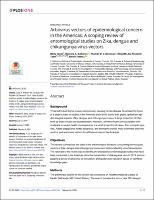| dc.creator | Jones, Reilly | |
| dc.creator | Kulkarni, Manisha A. | |
| dc.creator | Davidson, Thomas M. V. | |
| dc.creator | Sander, Beate | |
| dc.creator | González, Camila | |
| dc.creator | Wu, Jianhong | |
| dc.creator | Miretti, Marcos Mateo | |
| dc.creator | Espinel, Mauricio | |
| dc.creator | Cevallos Viteri, Varsovia Enid | |
| dc.creator | Talbot, Benoit | |
| dc.date.accessioned | 2023-08-24T12:51:24Z | |
| dc.date.available | 2023-08-24T12:51:24Z | |
| dc.date.issued | 2022-02-06 | |
| dc.identifier.citation | Jones, R., Kulkarni, M.A., Davidson, T.M.V., Sander, B., González, C., Wu, J.,...Talbot, B. (2020). Arbovirus vectors of epidemiological concern in the Americas : a scoping review of entomological studies on zika, dengue and chikungunya virus vectors. Plos One. Estados Unidos : Public Library of Science, 15, pp. 1-17. | es_AR |
| dc.identifier.issn | 1932-6203 | |
| dc.identifier.other | 26019 | |
| dc.identifier.other | CCPI-CNyE-A-138 | |
| dc.identifier.uri | https://hdl.handle.net/20.500.12219/5076 | |
| dc.description | Fil: Jones, Reilly. University of Toronto; Canadá. | es_AR |
| dc.description | Fil: Kulkarni, Manisha A. University of Ottawa; Canadá. | es_AR |
| dc.description | Fil: Davidson, Thomas M. V. University of Toronto; Canadá. | es_AR |
| dc.description | Fil: Sander, Beate. Public Health Ontario; Canadá. | es_AR |
| dc.description | Fil: González, Camila. Universidad de Los Andes; Venezuela. | es_AR |
| dc.description | Fil: Wu, Jianhong. York University ; Canadá. | es_AR |
| dc.description | Fil: Miretti, Marcos Mateo. Consejo Nacional de Investigaciones Científicas y Técnicas. Centro Científico Tecnológico (Nordeste). Instituto de Biología Subtropical; Argentina. | es_AR |
| dc.description | Fil: Miretti, Marcos Mateo. Universidad Nacional de Misiones. Centro Científico Tecnológico (Nordeste). Instituto de Biología Subtropical; Argentina. | es_AR |
| dc.description | Fil: Espinel, Mauricio. Universidad Laica Elroy Alfaro de Manabí; Ecuador. | es_AR |
| dc.description | Fil: Cevallos Viteri, Varsovia Enid. Instituto Nacional de Salud Pública; Ecuador. | es_AR |
| dc.description | Fil: Cevallos, Varsovia. Instituto Nacional de Salud Pública; Ecuador. | es_AR |
| dc.description | Fil: Talbot, Benoit. University of Ottawa; Canadá. | es_AR |
| dc.description.abstract | Background Three arthropod-borne viruses (arboviruses) causing human disease have been the focus of a large number of studies in the Americas since 2013 due to their global spread and epidemiological impacts: Zika, dengue, and chikungunya viruses. A large proportion of infections by these viruses are asymptomatic. However, all three viruses are associated with moderate to severe health consequences in a small proportion of cases. Two mosquito species, Aedes aegypti and Aedes albopictus, are among the world´s most prominent arboviral vectors, and are known vectors for all three viruses in the Americas. Objectives This review summarizes the state of the entomological literature surrounding the mosquito vectors of Zika, dengue and chikungunya viruses and factors affecting virus transmission. The rationale of the review was to identify and characterize entomological studies that have been conducted in the Americas since the introduction of chikungunya virus in 2013, encompassing a period of arbovirus co-circulation, and guide future research based on identified knowledge gaps.
Methods The preliminary search for this review was conducted on PubMed (National Library of Health, Bethesda, MD, United States). The search included the terms ´zika´ OR ´dengue´ OR ´chikungunya´ AND ´vector´ OR ´Aedes aegypti´ OR ´Aedes albopictus´. The search was conducted on March 1st of 2018, and included all studies since January 1st of 2013.
Results A total of 96 studies were included in the scoping review after initial screening and subsequent exclusion of out-of-scope studies, secondary data publications, and studies unavailable in English language.
Key findings We observed a steady increase in number of publications, from 2013 to 2018, with half of all studies published from January 2017 to March 2018. Interestingly, information on Zika virus vector species composition was abundant, but sparse on Zika virus transmission dynamics. Few studies examined natural infection rates of Zika virus, vertical transmission, or co-infection with other viruses. This is in contrast to the wealth of research available on natural infection and co-infection for dengue and chikungunya viruses, although vertical transmission research was sparse for all three viruses. | es_AR |
| dc.format | application/pdf | |
| dc.format.extent | 789 KB | |
| dc.language.iso | eng | es_AR |
| dc.publisher | Public Library of Science | es_AR |
| dc.relation | info:eu-repo/semantics/altIdentifier/urn/https://pubmed.ncbi.nlm.nih.gov/32027652/ | |
| dc.relation | info:eu-repo/semantics/altIdentifier/doi/http://dx.doi.org/10.1371/journal.pone.0220753 | |
| dc.relation | info:eu-repo/semantics/altIdentifier/hdl/http://hdl.handle.net/11336/152816 | |
| dc.relation | info:eu-repo/semantics/altIdentifier/urn/https://www.ncbi.nlm.nih.gov/pmc/articles/PMC7004335/pdf/pone.0220753.pdf | |
| dc.rights | info:eu-repo/semantics/openAccess | |
| dc.subject | Arbovirus | es_AR |
| dc.subject | Arboviral vectors | es_AR |
| dc.subject | Epidemiology | es_AR |
| dc.subject | Review | es_AR |
| dc.title | Arbovirus vectors of epidemiological concern in the Americas : a scoping review of entomological studies on zika, dengue and chikungunya virus vectors | es_AR |
| dc.type | info:eu-repo/semantics/article | |
| dc.type | info:ar-repo/semantics/artículo | |
| dc.type | info:eu-repo/semantics/publishedVersion | |



